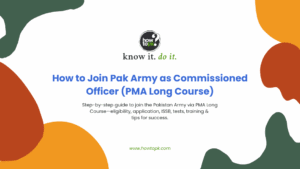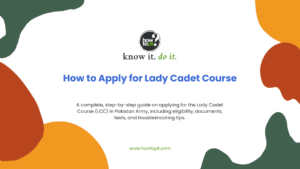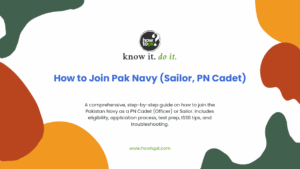Becoming a fighter pilot in the Pakistan Air Force (PAF) is a calling, not just a career. It’s a path chosen by individuals who possess an unwavering spirit, exceptional intellect, robust physical health, and an unyielding commitment to their nation. This comprehensive guide is designed to be your ultimate one-stop resource, meticulously detailing every step of this challenging yet profoundly rewarding journey.
Whether you’re just beginning to dream of the skies or are already well into your preparations, this guide will provide the insights, practical advice, and detailed roadmap you need to navigate the rigorous selection and training process.
The Dream of Flying: Is It Truly for You?
Before embarking on this arduous yet exhilarating journey, take a moment to reflect on what truly drives you. Becoming a fighter pilot is far more than just the thrill of speed and altitude. It demands absolute precision under unimaginable pressure, critical thinking in life-or-death situations, seamless teamwork, and a relentless pursuit of perfection.
You’ll be entrusted with multi-million dollar assets and, more importantly, with the safety and sovereignty of your country. This role requires individuals who can lead, adapt, learn continuously, and maintain composure when everything is on the line.
If your passion for aviation is matched by a deep sense of responsibility, a commitment to discipline, and a resilient spirit, then the skies of the PAF might indeed be your destiny.
Step 1: Meeting the Initial Eligibility Criteria – The Foundation of Your Dream
The very first and most critical stage of your journey involves ensuring you meet the fundamental requirements set by the Pakistan Air Force. These criteria are non-negotiable and serve as the baseline for your application. Understanding them thoroughly from the outset will save you time and effort.
| Section | Content |
|---|---|
| Nationality | Requirement: Must be a citizen of Pakistan. Why: The PAF defends Pakistan’s airspace and only recruits citizens with undivided loyalty. Note: Dual nationals are usually required to renounce their foreign nationality before or during final selection. |
| Age Limitations | For GDP (fighter pilot) applicants:
Age is counted from the last date of application submission. Why: The training is long, physically intense, and demands quick learning — younger candidates adapt more easily. Tip: If near the upper limit, plan to apply as soon as you meet the educational criteria and the PAF announces openings. |
| Marital Status | Requirement: GDP candidates must be unmarried during application and initial training. Reason: Training at PAF Academy Risalpur is immersive, with strict discipline and minimal outside contact. Marriage can add commitments that reduce focus. |
| Gender | Historically, GDP was male-only, but the PAF now has female fighter pilots. Opportunities for women in combat roles are growing, though numbers are still small. Tip: Always check the latest PAF advertisements to see if females can apply for GDP in the current cycle. |
| Educational Qualifications | Minimum: FSc or equivalent (A-Levels). Accepted streams:
Marks: Minimum 60% aggregate. Why these subjects: Physics teaches aerodynamics and forces; Math is essential for navigation and avionics; English is vital for global aviation communication. Tip: Understand concepts, not just memorize. Pre-Medical students should plan for Additional Math early. |
| Physical Standards | Height:
Weight: Must be proportionate to height (per PAF standards). Vision:
Health: No chronic or limiting conditions; must be fit for high G-forces. Tip: Start fitness training early (cardio + strength), eat well, and protect your eyesight. |
Step 2: The Application Process – Your Official Entry Point
Once you have meticulously checked and confirmed that you meet all the initial eligibility criteria, the next logical step is to formally submit your application to the Pakistan Air Force.
| Section | Content |
|---|---|
| Watch for Induction Advertisements | Timing: The PAF usually announces GDP branch induction twice a year — spring and autumn — but dates may vary slightly. Where to Look:
What to Look For:
Tip: Set reminders for typical induction months. Apply early once the ad appears — don’t wait until the deadline. |
| Online Registration – The Digital Gateway | The PAF now uses online registration as the main application method. Process:
Tip: Gather all required documents before starting. Use a stable internet connection. For technical issues, call the PAF helpline or visit your nearest AS&RC. |
Step 3: Initial Tests at the AS&RC – The First Filtration
Once you have registered, you will be called to your chosen Airmen Selection & Recruitment Centre (AS&RC) for the initial phase of selection. This stage is designed to filter out a large number of candidates based on intelligence, academic knowledge, and preliminary physical and medical suitability.
3.1 Reporting to the AS&RC
- What to Bring: On your designated date and time, report to the AS&RC with your original CNIC/B-Form, your printed registration slip, and all original academic documents (Matric, FSc/A-Levels mark sheets and certificates).
- Dress Code: Dress smartly and appropriately. This shows respect and seriousness.
- Mindset: Be punctual, confident, and prepared. This is your first direct interaction with the PAF selection system.
3.2 Computer-Based Intelligence Test
This is typically the first test you will face, designed to assess your cognitive abilities and how quickly and accurately you can process information. It’s usually a timed, multiple-choice test conducted on computers.
| Type | What it Assesses | Types of Questions |
|---|---|---|
| Verbal Intelligence | Your ability to understand and reason with words, concepts, and language. | Analogies (e.g., “Bird is to Air as Fish is to…?”), series completion (e.g., “Cat, Dog, Fox, …?”), coding/decoding, jumbled words, synonyms, antonyms, and verbal logic. |
| Non-Verbal Intelligence | Your ability to interpret patterns, shapes, figures, and spatial relationships without relying on language. Gauges visual reasoning and abstract problem-solving skills. | Figure series completion, odd-one-out (figures), matrix reasoning, spatial reasoning (rotated or mirrored shapes), and pattern recognition in abstract designs. |
Practical Tip: Practice is paramount. Purchase books specifically designed for PAF intelligence tests, or find online resources. Focus on understanding the patterns and logic behind different question types. Time management is critical; learn to work quickly and accurately. Don’t spend too much time on a single question; move on if you’re stuck and return later if time permits.
3.3 Academic Test
This test directly assesses your knowledge in key subjects from your Intermediate (FSc) curriculum. It’s usually a multiple-choice question (MCQ) format, also conducted on a computer.
| Subject | What it Tests |
|---|---|
| English | Tests grammar, vocabulary, sentence structure, comprehension, and error identification. Includes verb tenses, parts of speech, active/passive voice, direct/indirect speech, synonyms, antonyms, and passage comprehension. |
| Physics | Covers mechanics (force, motion, work, energy), electricity and magnetism (circuits, current, fields), waves (light, sound), thermodynamics, and modern physics basics. |
| Mathematics | Focuses on algebra, trigonometry, geometry, and basic calculus. Pre-Medical students should ensure Additional Math concepts are strong. |
| General Knowledge | Occasionally includes current affairs, Pakistan studies, and basic world geography. |
Practical Tip: Thoroughly revise your FSc textbooks for English, Physics, and Mathematics. Don’t just memorize; understand the concepts. Solve past papers if you can access them, as they provide insight into the typical question formats and difficulty levels. Many coaching academies offer preparatory courses for these tests; consider joining one if you feel you need structured guidance and practice.
3.4 Preliminary Medical Examination
After clearing the intelligence and academic tests, you’ll undergo an initial, basic medical check-up at the AS&RC itself. This is a preliminary screening to filter out obvious disqualifying conditions.
| Component | What it Involves |
|---|---|
| Eyesight Test | Basic vision charts (Snellen chart) to check distant and near vision, plus a color blindness test using Ishihara plates (colored dots forming numbers/shapes). Difficulty identifying these indicates color blindness, which is disqualifying for GDP. |
| Height and Weight Measurement | Precise height measurement and weight check against PAF’s height-to-weight ratio standards. |
| Basic Physical Check | General examination for deformities (knocked knees, flat feet, curved spine), skin conditions, and other obvious health issues. Includes physique and limb check. |
Practical Tip: Ensure you are well-rested on the day of the test. Maintain good hygiene. If you suspect any minor vision issues or have doubts about color perception, it’s advisable to get a professional eye check-up before applying. Be honest about your medical history.
3.5 Preliminary Interview
If you successfully clear the intelligence, academic, and preliminary medical tests, you will have a brief interview at the AS&RC.
| Aspect | Details |
|---|---|
| Who Conducts It | Usually conducted by a junior officer, such as a Squadron Leader or Flight Lieutenant. |
| Purpose | Initial assessment of personality, confidence, communication skills, motivation for joining the PAF, and general awareness. |
| What to Expect |
|
Practical Tip: Dress smartly (preferably in formal attire). Be confident, polite, and articulate. Maintain eye contact. Practice answering common interview questions beforehand. Research basic facts about the Pakistan Air Force (its role, current aircraft, significant achievements) and stay updated on important national news. Avoid giving rehearsed or dishonest answers; be genuine.
Step 4: ISSB (Inter Services Selection Board) – The Ultimate Personality and Leadership Crucible
The Inter Services Selection Board (ISSB) is, without a doubt, the most comprehensive and challenging phase of the entire selection process. It’s a four-day residential evaluation designed to assess your psychological makeup, leadership potential, and overall suitability for a commissioned officer’s role in the armed forces. It doesn’t just test what you know, but who you are under various circumstances.
Candidates who clear the AS&RC stage are issued call-up letters for ISSB. There are four ISSB centers in Pakistan: Kohat, Gujranwala, Malir (Karachi), and Quetta. You will be assigned to one of these.
What Happens at ISSB? A Day-by-Day Breakdown
You will be part of a group of candidates, and throughout the four days, you will be continuously observed and evaluated by a team of psychologists, group testing officers (GTOs), and interviewing officers.
Day 1: Arrival & Psychological Tests
| Test Component | Details |
|---|---|
| Arrival and Reporting | On arrival at the ISSB center, complete registration, receive a chest number, and get briefed on the schedule. Accommodation and meals are provided within the center. |
| Psychological Tests Overview | Written assessments by psychologists to measure personality traits, emotional stability, motivation, and leadership qualities. Designed to be resistant to “faked” responses. |
| Picture Story Writing | Shown ambiguous pictures briefly, then write a story about each including events before, during, and after the scene. Measures optimism, creativity, and problem-solving approach. |
| Word Association Test (WAT) | Shown a single word briefly, then write the first thought or sentence that comes to mind. Evaluates spontaneity, thought patterns, and personality traits. |
| Sentence Completion Test (SCT) | Given incomplete sentences to finish. Provides insights into attitudes, aspirations, values, and emotional state. |
| Thematic Apperception Test (TAT) | Similar to picture story writing but with more abstract images, requiring greater imaginative input. |
| Self-Description Test (SDT) | Write about yourself from multiple perspectives—self, parents, friends, teachers/colleagues—and qualities to develop. Assesses self-awareness and honesty. |
Practical Tip: Be honest and natural in your responses. Don’t try to guess what the “right” answer is; psychologists are trained to detect inconsistencies. Focus on positive themes in your stories and associations. Practice creative writing and rapid thought articulation. Avoid presenting an overly perfect or fake image; authenticity is valued.
Day 2 & 3: Group Tasks & Interview – Leadership in Action
These are the most dynamic days, involving both outdoor and indoor activities where your physical and mental attributes are assessed in a group setting. Your interactions with other candidates and your approach to challenges are closely observed.
| Task/Component | Details |
|---|---|
| Group Discussion (GD) | Discussion on a current affairs topic or general problem. Evaluated on clarity, listening skills, constructive contribution, and positive group influence without dominating. |
| Group Planning (GP) | Given a hypothetical scenario (e.g., rescue mission) to plan as a group within a time limit. Tests problem-solving, logical thinking, planning, and collaboration. |
| Progressive Group Task (PGT) | Outdoor obstacle tasks for the whole group using limited resources under specific rules. Difficulty increases progressively. Tests teamwork, initiative, agility, and adherence to rules. |
| Half Group Task (HGT) | Similar to PGT but with a smaller group for more focused individual assessment in teamwork and leadership. |
| Individual Obstacles | Physical challenges (e.g., high jump, wall climb) completed individually within a time limit. Assesses courage, agility, determination, and fitness. Effort is valued even if not all obstacles are completed. |
| Command Task (CT) | Lead a small team to solve a given obstacle. Assesses leadership style, decision-making under pressure, delegation, and communication skills. |
| Interview with President/Deputy President | One-on-one interview with a senior officer covering life, motivations, knowledge, hobbies, strengths, weaknesses, and aspirations. Cross-checks earlier assessments and may involve challenging questions. |
Practical Tip: For group tasks, be an active participant, but don’t try to dominate. Listen to others’ ideas, offer constructive suggestions, and demonstrate cooperation. Show initiative. For the interview, be confident, honest, and articulate. Research current affairs thoroughly, especially those related to Pakistan’s defense, economy, and international relations. Practice speaking clearly and concisely. Dress formally and maintain proper etiquette throughout your stay.
Day 4: Final Formalities & Departure
- Briefings and Formalities: On the final day, there might be some concluding briefings, feedback sessions (not always individual), and final administrative checks.
- Departure: You will then be released to depart from the ISSB center.
- Results: The results of the ISSB are typically not announced on the spot. They are sent to Air Headquarters, and you will be informed of your selection or non-selection at a later stage, usually several weeks after the board.
- Practical Tip: Even after all tasks are done, maintain your discipline and composure until you depart. Your behavior is observed until the very end.
Step 5: Medical Examination by Central Medical Board (CMB) – The Ultimate Health Check
If you successfully clear the ISSB, you will receive a call-up letter for a detailed medical examination by the Central Medical Board (CMB). This is a far more comprehensive and rigorous medical assessment than the preliminary check at the AS&RC. This examination is usually conducted at a designated Pakistan Air Force Hospital, often the PAF Hospital Masroor in Karachi, or another major military hospital.
What the CMB Exam Entails:
The CMB involves a battery of tests and consultations with various specialists to ensure you are in perfect health and free from any condition that could impair your performance as a pilot or lead to a medical emergency during flight.
| Aspect | Details |
|---|---|
| General Check-up | Head-to-toe examination by a general physician to assess overall health. |
| Systemic Review | Detailed check of cardiovascular, respiratory, digestive, nervous, musculoskeletal, and genitourinary systems. |
| Orthopedic Assessment | Checks for flat feet, knocked knees, spinal deformities, and joint issues. Includes movement tests for flexibility and range of motion. |
| Detailed Eye Examination |
|
| ENT Examination |
|
| Dental Examination | Full check-up for cavities, missing teeth, gum health, and orthodontic issues. Certain conditions may require treatment before acceptance. |
| Laboratory Tests |
|
| Imaging & Specialized Tests |
|
Practical Tip: Be completely honest about your medical history during the process. Any concealment found later can lead to severe consequences. Maintain excellent personal hygiene. Get a general health check-up from your family doctor before applying, particularly for vision and hearing. Ensure you are well-rested and hydrated for the examinations. Avoid consuming any food or drink that might interfere with blood or urine tests (e.g., excessive caffeine or sugary drinks).
Common Medical Disqualifications for GDP (beyond general health issues):
- Any degree of color blindness.
- Significant uncorrected refractive errors (even if correctable with glasses).
- History of migraines, seizures, or any neurological disorder.
- Chronic respiratory conditions like asthma.
- Cardiovascular issues (e.g., murmurs, arrhythmias).
- Hearing loss beyond acceptable limits.
- Certain skin conditions (e.g., severe eczema) that could be exacerbated by flying gear.
- Any past surgery that might leave a functional impairment.
Step 6: Flying Aptitude Test (FAT) – The Pilot’s Innate Instincts
The Flying Aptitude Test (FAT) is a specialized test specifically designed for GDP candidates. It is usually conducted after you have cleared the ISSB and CMB, often at a dedicated PAF base with flight simulators or specialized equipment. This test is crucial because it assesses your innate, natural ability to learn and perform complex flying tasks.
Purpose and Components:
The FAT doesn’t test your knowledge of aviation theory, but rather your psychomotor skills, hand-eye coordination, spatial awareness, and ability to process information rapidly and accurately in a dynamic, simulated flying environment.
| Aspect | Details |
|---|---|
| Psychomotor Skills Assessment | Measures fine motor control, reaction time, and precision in manipulating controls. |
| Hand-Eye Coordination | Tests your ability to coordinate visual input with physical responses—critical for aircraft control. |
| Spatial Orientation/Awareness | Assesses ability to understand and maintain orientation in three-dimensional space for navigation and maneuvering. |
| Multi-tasking & Divided Attention | Scenarios where you must track parameters, follow instructions, and operate controls simultaneously. |
| Decision-Making Under Pressure | Quick decisions under time constraints, simulating real cockpit demands. |
| How It’s Conducted |
|
Practical Tip: There isn’t much specific “studying” for FAT as it tests inherent abilities. However, you can improve your general psychomotor skills and hand-eye coordination through:
- Video Games: Games that require precise control, rapid decision-making, and tracking (e.g., flight simulators, racing games, or even fast-paced action games) can subtly enhance relevant skills.
- Cognitive Exercises: Puzzles, brain teasers, and activities that improve focus and multi-tasking can be beneficial.
- Stay Calm: On the day of the test, ensure you are well-rested, calm, and focused. Listen to instructions carefully and try to remain composed even if you feel challenged.
Step 7: Final Merit List and Selection – The Moment of Truth
After successfully navigating all the preceding challenging stages – the initial tests, ISSB, CMB, and FAT – your comprehensive performance profile is compiled and sent to Air Headquarters for final selection.
- Factors Contributing to Merit: Your overall merit position is determined by a holistic assessment of your performance across all stages. This includes your scores in the initial intelligence and academic tests, your performance in the ISSB (psychological assessments, group tasks, and interviews), the clean bill of health from the CMB, and your score in the Flying Aptitude Test. Academic excellence, demonstrated leadership qualities, psychological stability, physical fitness, and innate flying aptitude all contribute significantly.
- Highly Competitive Nature: It’s crucial to understand that even if you have cleared all the stages, selection is not guaranteed. The number of successful candidates far exceeds the available vacancies in each induction cycle. Therefore, only the top candidates on the final merit list are selected. The competition is intense, and selection is based on being among the very best.
- Issuance of Joining Instructions: If you are among the selected few, you will receive an official call-up letter or joining instructions from Air Headquarters. This letter will specify your reporting date and location for joining the Pakistan Air Force Academy in Risalpur. This is the official confirmation of your selection and the start of your journey as a PAF cadet.
- Practical Tip: While awaiting results, maintain your fitness and continue to refine your academic knowledge. Prepare mentally for the demanding training ahead. Be patient, as the final selection process can take some time.
Step 8: Training at PAF Academy, Risalpur – Forging the Future Pilot
Congratulations! Reaching this stage means you have proven yourself among the most promising candidates in the nation. Your journey as a civilian ends here, and your transformation into a future officer and pilot begins at the prestigious Pakistan Air Force Academy, Risalpur. This is an integrated training program that combines military, academic, and flying training over a period of usually 3 to 4 years.
8.1 Basic Military Training (BMT) – The Foundation of Discipline
| Aspect | Details |
|---|---|
| Purpose | The initial phase instills military discipline, physical fitness, and foundational officer knowledge—transforming civilians into military personnel. |
| What You’ll Learn |
|
Practical Tip: Enter the academy in the best physical shape possible. This will help you cope with the initial intensity. Mental preparedness for strict discipline and living away from home is also crucial.
8.2 Academic Training (Undergraduate Degree) – The Intellectual Edge
Alongside your military and flying training, you will pursue a Bachelor’s degree, typically a Bachelor of Science (BS) in Aviation Sciences and Management, which is affiliated with Air University, Islamabad.
| Aspect | Details |
|---|---|
| Subjects |
|
Practical Tip: Maintain a keen interest in your academic subjects. They directly support your flying training. Form study groups with your peers to help understand complex concepts.
8.3 Flying Training – The Path to the Cockpit
This is the most anticipated and specialized part of your training, progressing through different aircraft types and levels of complexity.
| Phase | Focus |
|---|---|
Primary Flying Training (PFT) MFI-17 Mushshak (propeller-driven trainer) |
|
Basic Flying Training (BFT) Super Mushshak, T-37 Tweet (jet trainer) |
|
Advanced Jet Training (AJT) K-8 Karakoram (modern jet trainer) |
|
Challenges during Training (“Chopping”):
- The training is exceptionally demanding. Long hours, constant evaluations (academic, physical, and flying), and high-pressure situations are the norm.
- A significant challenge is the possibility of being “chopped” (disqualified or washed out) at any stage if you do not meet the required standards. This can happen for various reasons: consistently failing to meet flying standards, academic deficiencies, medical issues that develop during training, or disciplinary problems. This is a tough reality, but it ensures only the most capable and suitable individuals graduate as pilots.
Practical Tip: Embrace continuous learning. Listen intently to your instructors, practice diligently, and seek feedback constantly. Develop mental resilience to handle setbacks and pressure. Maintain peak physical fitness throughout your training.
Step 9: Specialization and Operational Conversion Unit (OCU) – Mastering the Combat Machine
Upon successful graduation from the Pakistan Air Force Academy, you will be commissioned as a Pilot Officer. While you are now a trained pilot, your journey to becoming a fighter pilot on a specific combat aircraft begins at an Operational Conversion Unit (OCU).
| Purpose and Aircraft Types | Intensive Training Focus |
|---|---|
Transition newly commissioned pilots from trainer aircraft to specific operational fighter aircraft, mastering a combat platform.
|
|
Step 10: Becoming an Operational Fighter Pilot – The Elite of the Skies
Upon successful completion of your OCU training and earning your “Combat Ready” status on a specific fighter aircraft, you will be posted to an operational fighter squadron. This is the culmination of years of relentless effort and training.
| Career Stage | Responsibilities & Focus | Progression Opportunities |
|---|---|---|
| Junior Pilot (Wingman) | Fly alongside senior pilots, execute orders, integrate into squadron rhythm, learn operational tactics. | Gain flight hours, develop tactical proficiency, participate in exercises. |
| Section Lead | Lead two aircraft in tactical maneuvers, ensure coordination and mission success. | Demonstrate leadership and decision-making in complex flight scenarios. |
| Flight Lead | Command a flight of four aircraft, plan missions, and manage in-flight execution. | Prepare for higher command roles through operational leadership experience. |
| Squadron Leader / Commander | Oversee squadron personnel, training programs, and operational missions. | Further advance to wing or base-level leadership. |
| Instructor Pilot | Train and mentor new fighter pilots, pass on advanced combat tactics and flying skills. | Attain recognition as a subject matter expert. |
| Weapons School Graduate | Specialize in advanced air combat tactics and precision weapon employment. | Serve as a tactical advisor or mission planner at the highest levels. |
| Test Pilot | Evaluate new aircraft, weapons systems, and avionics for operational deployment. | Influence future PAF capabilities and modernization efforts. |
| Staff Appointments | Contribute in administrative, strategic planning, and policy-making roles at HQ levels. | Transition to senior Air Force leadership roles. |
| Continuous Training & Evaluation | Participate in exercises, specialized courses, and evaluations to adapt to new threats and technologies. | Maintain operational edge and readiness for rapid deployment. |
Common Issues and How to Troubleshoot Them Effectively
The journey to becoming a PAF fighter pilot is arduous, and it’s common for aspiring candidates to encounter various hurdles. Understanding these potential issues and knowing how to troubleshoot them can significantly improve your chances of success.
| Stage / Problem | Troubleshooting |
|---|---|
Initial Eligibility & Application Phase Not meeting age or academic percentage criteria | Age: If underage, wait for next induction; if close to upper limit, apply as soon as advertisements appear. No flexibility on cut-off dates. Academics: Below 60% in FSc/A-Levels generally means ineligibility for GDP. Improve results if still studying, or consider graduate-level entry with slightly relaxed criteria. Explore other PAF branches with different academic requirements. |
Initial Eligibility & Application Phase Incorrect or incomplete online application | Double-check all fields before submission with original documents on hand. If error found before deadline, check for editing option or contact PAF helpline/AS&RC. Always print registration slip. |
Initial Eligibility & Application Phase Missing the application deadline | Wait for next induction cycle. Track advertisements and set reminders for deadlines. |
Initial Tests at AS&RC Failing the Intelligence Test | Practice with dedicated PAF preparation books or online platforms. Manage time; don’t get stuck on one question. Recognize common logical patterns through repeated practice. |
Initial Tests at AS&RC Failing the Academic Test | Revisit FSc/A-Level textbooks for conceptual clarity. Use past papers to understand question trends. Focus extra time on weak topics; consider a tutor if needed. |
Initial Tests at AS&RC Medical disqualification (eyesight/physical) | Color blindness is an absolute disqualifier for GDP. For vision issues, consult an ophthalmologist beforehand. Meet height/weight standards; maintain good health. |
ISSB Stage
|
|
Central Medical Board (CMB) Discovery of permanent disqualifying condition | Maintain lifelong health, get pre-CMB check-up, and be honest about history. No exceptions for GDP medical standards. |
Flying Aptitude Test (FAT) Poor performance (coordination/reaction time) | No direct coaching available; improve hand-eye coordination and spatial reasoning through activities. Be well-rested and focused; listen carefully to instructions. |
Training at PAF Academy (Risalpur) “
|
|
General Troubleshooting Advice for the Entire Process:
- Positive Mindset: Maintain a positive, determined, and resilient attitude throughout.
- Physical and Mental Health: Prioritize both. A healthy body supports a healthy mind.
- Honesty and Integrity: Be truthful in all your responses and declarations. Integrity is a core value of the armed forces.
- Research and Awareness: Be well-informed about the PAF, its operations, and current affairs.
- Seek Guidance: If possible, talk to current or retired PAF officers or cadets. Their experiences can provide invaluable insights.
- Learn from Every Step: Whether you pass or fail a particular stage, learn from the experience. Every attempt builds resilience and knowledge.
The path to becoming a fighter pilot is a testament to perseverance and commitment. By understanding the challenges and preparing effectively, you significantly increase your chances of achieving this extraordinary dream.
Related Posts
- Age, Height, Education Requirements for Pak Army, Navy and PAF
- How to Apply for Lady Cadet Course (LCC) of Pak Army
- How to Do Online Registration for ISSB
- How to join Pak Army as Commissioned Officer (PMA Long Course)
- How to Join Pak Navy (Sailor, PN Cadet)
- How to Join Pakistan Air Force (PAF) as Fighter Pilot
- How to Join Pakistan Armed Forces: Ultimate Guide (Army, Navy & Air Force) 2025
- How to Pass Pakistan Army, Air Force and Navy Physical and Medical Tests
- How to Prepare for Initial Tests in Army, Navy and PAF
- Pak Army Soldier Jobs: An 8 Step Guide to Apply & Succeed
- What are the Required Documents for Forces Recruitment in Pakistan





